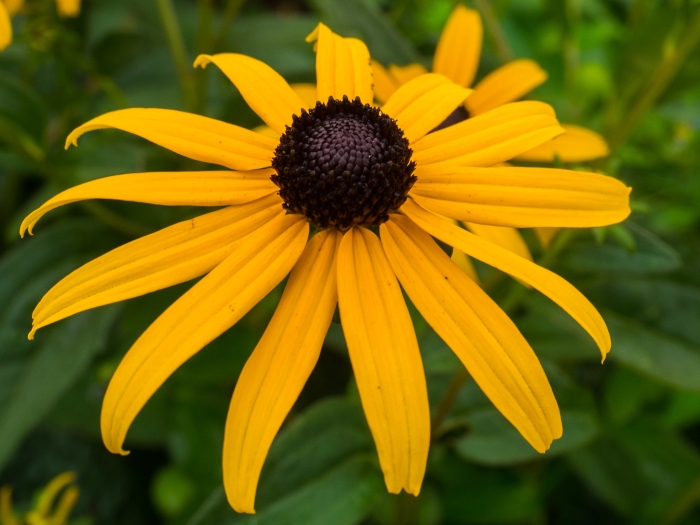Black-Eyed Susan
(Rudbeckia sullivantii)
Black-Eyed Susan (Rudbeckia sullivantii)
/
/

F. D. Richards
CC BY-SA 2.0
Image By:
F. D. Richards
Recorded By:
Copyright:
CC BY-SA 2.0
Copyright Notice:
Photo by: F. D. Richards | License Type: CC BY-SA 2.0 | License URL: https://creativecommons.org/licenses/by/2.0/ | Uploader: F. D. Richards | Publisher: Flickr |






















Estimated Native Range
Summary
Rudbeckia sullivantii, commonly known as Black-Eyed Susan, is a deciduous perennial herb native to open woodlands, prairies, and fields in the East-Central United States. It typically grows to a height of 2-3 feet (0.6-0.9 meters) and a width of 1-2 feet (0.3-0.6 meters). The plant features a clumping form with lance-shaped leaves and a profusion of daisy-like flowers with dark brown central cones and bright yellow petals that bloom from midsummer to early fall, providing a long season of color.
Black-Eyed Susan is valued for its vibrant flowers that attract pollinators such as butterflies and bees, making it an excellent choice for wildlife gardens. It is also used in mass plantings, borders, and as a cut flower due to its showy blooms. This plant is easy to grow, tolerating a range of soil conditions, though it prefers well-drained soils. It thrives in full sun but can tolerate light shade. While generally pest-free, it can occasionally suffer from powdery mildew or leaf spot. Deadheading spent flowers can encourage additional blooming and prevent excessive self-seeding.CC BY-SA 4.0
Black-Eyed Susan is valued for its vibrant flowers that attract pollinators such as butterflies and bees, making it an excellent choice for wildlife gardens. It is also used in mass plantings, borders, and as a cut flower due to its showy blooms. This plant is easy to grow, tolerating a range of soil conditions, though it prefers well-drained soils. It thrives in full sun but can tolerate light shade. While generally pest-free, it can occasionally suffer from powdery mildew or leaf spot. Deadheading spent flowers can encourage additional blooming and prevent excessive self-seeding.CC BY-SA 4.0
Plant Description
- Plant Type: Herb
- Height: 2-3 feet
- Width: 1-2 feet
- Growth Rate: Moderate
- Flower Color: Yellow
- Flowering Season: Summer, Fall
- Leaf Retention: Deciduous
Growth Requirements
- Sun: Full Sun
- Water: Low, Medium
- Drainage: Medium
Common Uses
Bee Garden, Bird Garden, Border Plant, Butterfly Garden, Deer Resistant, Drought Tolerant, Fire Resistant, Hummingbird Garden, Low Maintenance, Potted Plant, Rabbit Resistant, Salt Tolerant, Showy Flowers, Street Planting
Natural Habitat
Native to open woodlands, prairies, and fields in the East-Central United States
Other Names
Common Names:
Scientific Names: Rudbeckia fulgida var. sullivantii , Rudbeckia sullivantii , Rudbeckia speciosa var. sullivantii
GBIF Accepted Name: Rudbeckia sullivantii C.L.Boynton & Beadle